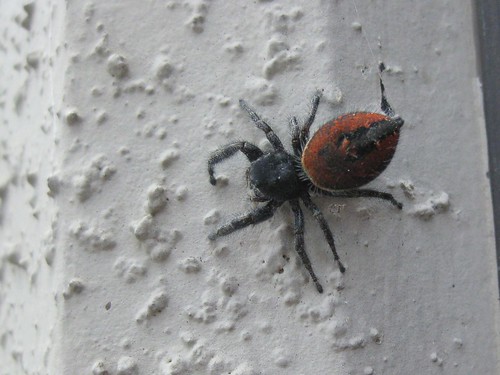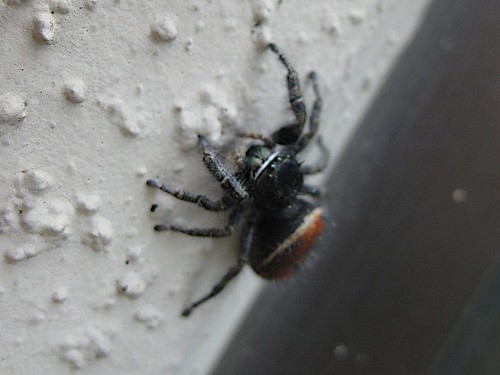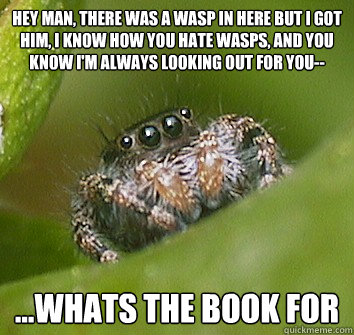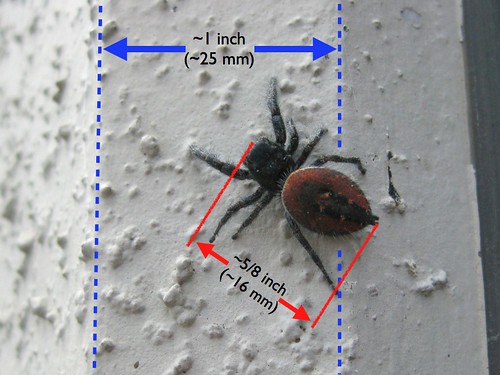 It’s always good to keep your eyes open, ready to see new things. I came across this striking not-particularly-small spider with a bright red velvety abdomen, just hanging out on the concrete side of a building here in Sunnyvale, California.
I’ve never seen one of these before! How might you go about identifying it?
If you start with any halfway decent identification guide, the first thing that they’ll suggest is to make sure that it’s really a spider, by looking for a few key markers: exactly two body sections, eight legs plus short pedipalps near the mouth, spinnerets, no wings, and no antennae.
And this fine creature passes all the tests with flying colors. Even the spinnerets are clearly visible.
Depending on the size (and speed) of your spider, going through that checklist can be quite a challenge, and may even involve a microscope. Fortunately, our fellow was only walking around slowly and not particularly tiny:
It’s always good to keep your eyes open, ready to see new things. I came across this striking not-particularly-small spider with a bright red velvety abdomen, just hanging out on the concrete side of a building here in Sunnyvale, California.
I’ve never seen one of these before! How might you go about identifying it?
If you start with any halfway decent identification guide, the first thing that they’ll suggest is to make sure that it’s really a spider, by looking for a few key markers: exactly two body sections, eight legs plus short pedipalps near the mouth, spinnerets, no wings, and no antennae.
And this fine creature passes all the tests with flying colors. Even the spinnerets are clearly visible.
Depending on the size (and speed) of your spider, going through that checklist can be quite a challenge, and may even involve a microscope. Fortunately, our fellow was only walking around slowly and not particularly tiny:
By comparing it to the angled features on the wall, we can see that the spider’s body (not counting the legs) is about 5/8″ (16 mm) long.
(The photo is also available without annotations, here.)And that’s about as far as the casual urban arachnologist can often get: We know that it’s a spider, that it’s relatively big, and that it has a red-velvet abdomen, vaguely resembling that of a velvet ant.
To go a little further, we’ll need some reference materials. The first step in identifying a spider’s species is to gaze deeply into its (plentiful, highly-acute) eyes. The arrangement of the eyes is one of the key factors that allows you to identify what family (and sometimes genus) a given spider belongs to.
So what have we got?
 From the front (and please forgive the poor macro focus from the pocket camera), there are two large center eyes, and two slightly smaller eyes positioned outside and above those two. All of these are on the very front facet of the cephalothorax (the frontmost body segment).
From the front (and please forgive the poor macro focus from the pocket camera), there are two large center eyes, and two slightly smaller eyes positioned outside and above those two. All of these are on the very front facet of the cephalothorax (the frontmost body segment). There are also two additional “upper” eyes, spaced further apart, and located way over at the top center of the spider’s cephalothorax. One of them is labeled by the upper arrow. And it’s not as clear, but perhaps we can also see two much smaller eyes there as well, halfway between the upper eyes and the eyes at front of the cephalothorax. One of these is at the location marked by the smaller arrow.
There are also two additional “upper” eyes, spaced further apart, and located way over at the top center of the spider’s cephalothorax. One of them is labeled by the upper arrow. And it’s not as clear, but perhaps we can also see two much smaller eyes there as well, halfway between the upper eyes and the eyes at front of the cephalothorax. One of these is at the location marked by the smaller arrow.
Now, the reference materials. There is a basic (but clear) illustrated chart of spider eye arrangments
available here and there is a more comprehensive guide (with a lot of pictures) available here. From these and other sources, we can recognize our spider’s eye arrangement as that of the family Salticidae, the jumping spiders.


Salticidae is actually the largest family of spiders, so we’re not done yet. With patience, we were able to use the Bug Guide to narrow our species down to one in the subfamily Dendryphantinae and specifically genus Phidippus.
And that is about as far as we– as amateurs –can be certain, with the added note that this spider is female, since it has the black feature in the middle of its abdomen which males lack. Precisely identifying a spider by species often involves microscopes and (sadly) better references than we have readily available. It often involves looking for specific morphology, rather than patterns or coloration (which tend to vary tremendously).We had initially been confident to identify this spider as Phidippus Johnsoni, commonly known as “Red-backed Jumping Spider” or as the “Johnson Jumper.” However, additional searching has shown us that these spiders vary tremendously beyond just the “cover shot.” Browsing through pages of images of these and similar species (Phidippus Carneus images here and Phidippus Johnsoni images here), it’s clear that there are significant normal variations between individuals of these species (and sub-morphs of these species), which leads to uncertainty compounded by the likelihood that some (or many) of those photos are misidentified in the first place. Judged from the body of available pictures (this one included), Phidippus Carneus seems like best match. Further, the sizes reported for Johnsoni seem to run a bit smaller than our example, at 9-14 mm, typically, while Carneus runs a bit larger at 15-17 mm.
And so here is our (hopefully) final word on the subject: Adult female spider of genus Phidippus, likely Phidippus Carneus. Have you ever come across one of these, or do you know how to identify these more precisely? We’d love to hear from you in the comments!







Aaaaaaaaaaaaaaaaaaaaaaaaaaaaaaaaaaaaaaaaaaaaaaaaaaaaaaargh.
Aaaaaaaaaaaaaaaaaaaaaaaaaaaaaaaaaaaaaaaaaaaaaaaaaaaaaaaaaaaaaaaaaaaaaargh.
Not a fan of spiders?
////\\\\::::////\\\\
Windell H. Oskay
drwho(at)evilmadscientist.com
http://www.evilmadscientist.com/
>8< Spider power!
Aw, she’s cute. Salticids are my favorite kind of spider, too. Usually quite photogenic. – Taryn
I think it’s an eight legged ewok, actually.
The spiders near my house apparently read my robots.txt before they crawl inside. Which is a good thing because I don’t want them inside.
I might not be visiting you guys for a while.
At least until Red and his buddies (I’m sure there are more) go away.
I’ll never forget the year I worked at Yahoo one spring they were inundated with giant spiders for a couple of months. Some 3x the size of red.
Totally freaked. I don’t like spiders.
Don’t worry; this wasn’t anywhere near our shop. ;)
Windell H. Oskay
drwho(at)evilmadscientist.com
http://www.evilmadscientist.com/
Nice Spider! Nice Photos too! I’ve kept Salticids as pets during the summer months since I was a kid. They make great terrarium pals and will usually start taking food from your hand within a week or two. I appreciate the arthropod post and would love to see more.
Thanks for the great walk-through. And of course the fun spider pics!
One thing I love about living in the Pacific Northwest is our relatively large spider population, along with our relatively low flying insect population. I admit, while I’ve never been terrified of spiders, they did used to creep me out a bit. But once I started thinking about how much good they are doing, I warmed up to them.
My spider highlight so far was holding a live tarantula at the Victoria Bug Zoo (British Columbia, Canada). Such a cool animal!
looks like a jumping spider. Jumping spiders are really smart. Submit the pics to http://www.whatsthatbug.com to get an exact answer.
Hey there’s also "project Noah" in this vein.
A few days later, a post for this same type of spider showed up on What’s That Bug: http://www.whatsthatbug.com/2012/03/25/jumping-spider-in-elyria-canyon-park/.
They’re calling it a Johnson Jumper.
A former student of mine’s brother did his Ph.D. on Pacific North West spider identification, and he told me that to get an exact ID, you needed to get into dissection with a microscope. I like spiders, so that wasn’t appealing to me – I’d rather have them spinning, jumping or building trapdoors than know what they are. Nice job on the ID, though. Those resources didn’t even exist a few years ago.
That’s my impression as well, and one of the reasons that I’m not claiming an exact ID here. :)
Windell H. Oskay
drwho(at)evilmadscientist.com
http://www.evilmadscientist.com/
First picture made me go ‘jumping spider!’ (The other reaction to it is ‘headlights!’, because that’s what the eyes look like.)
Four years in west Texas made me very familiar with P. audax, which likes the walls on buildings, and will come inside if there’s a door or window open. Fortunately they’re not really interested in people.
Neat! After reading through this I thought it’d be a good test for Google Image’s search for images by image. I fed it the URL to your second image and got an awful lot of results that told me machine image matching has a long ways to go. One image was of a spider though! Results here: https://www.google.com/search?hl=en&safe=off&tbs=simg:CAESZRpjCxCo1NgEGgIIAwwLELCMpwgaPAo6CAESFOwG6QbiA-cD0AevA6MDsAPPB64DGiCCimpmb3K1Sec5u_1eKl4ZkmoSHilZHR_1Z1i3ZQWGXVmgwLEI6u_1ggaCgoICAESBLoBVL4M&tbm=isch&sa=X&ei=ygtsT9nEGunbiAKQrez-BA&ved=0CFQQsw4&biw=1482&bih=1062
I then image searched for your best guess and got a ton of pictures of exactly your little beasty. To me the spider looks like it’s trying to imitate a lady bug.
Mike
to be fair Google image search is better at finding the same image in different sizes. For example you see some grainy over shared jpg on facebook you throw it into Google image search and you might be able to find the original author. Or you see a pic of a pretty girl and you wonder if there are anymore of her, Google image search might be able to help. I love Google image search for finding originals it’s kinda like a scavenger hunt except you have a blood hound named Google.
An excellent website to use for reverse image searches is TinEye.com
Great job identifying your jumping spider. I’ll bet you had fun with this challenge.
Just wanted to share standard conventions in scientific notation. Scientific names are always in [i]italics[/i] the genus is always Capitalized and the species is always not capitalized.
That was a great read. Thanks for the fun.
We found a female of this species etc. on May 17, 2012 in the Wenas Valley in eastern Washington.
Very interesting looking spider.